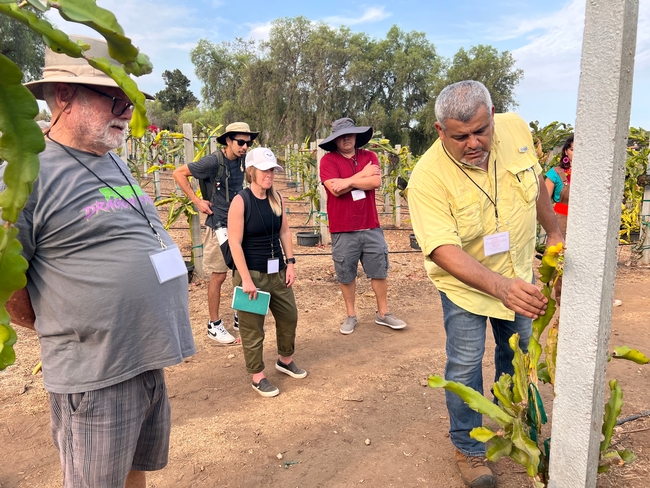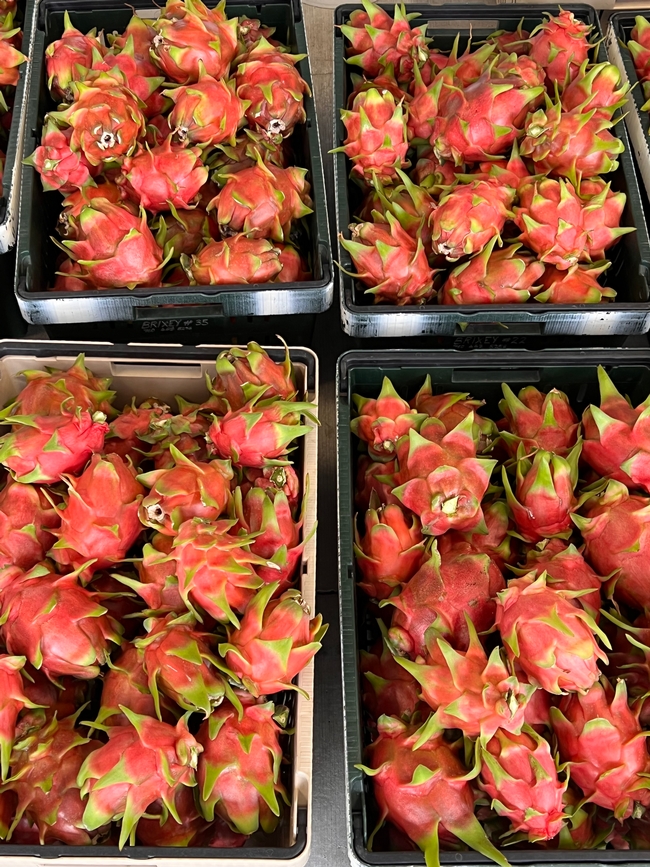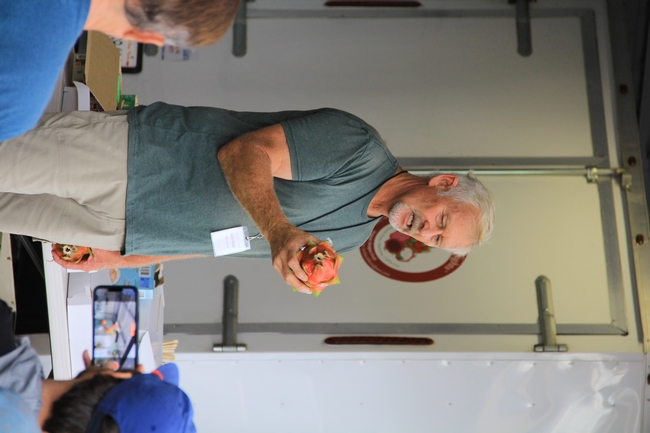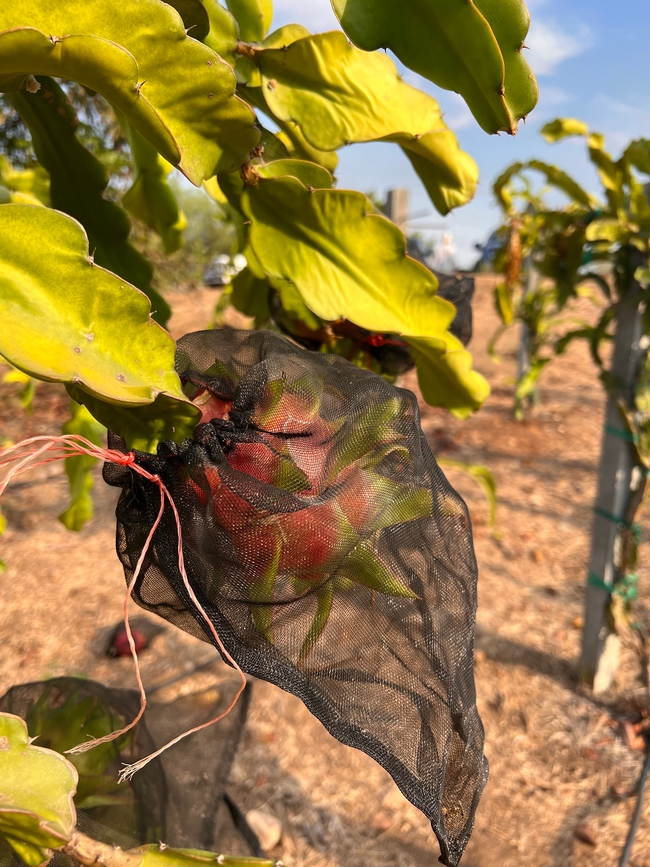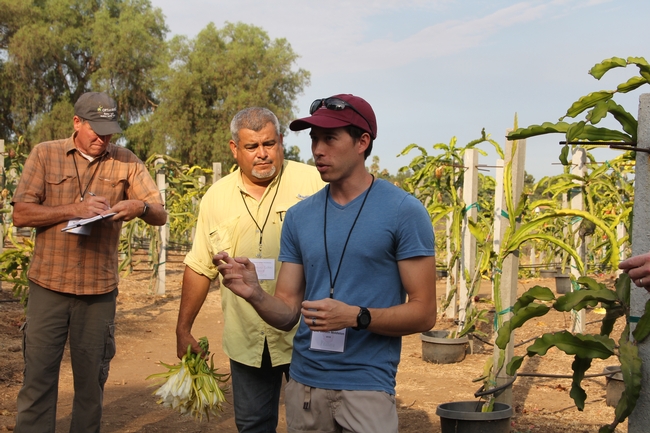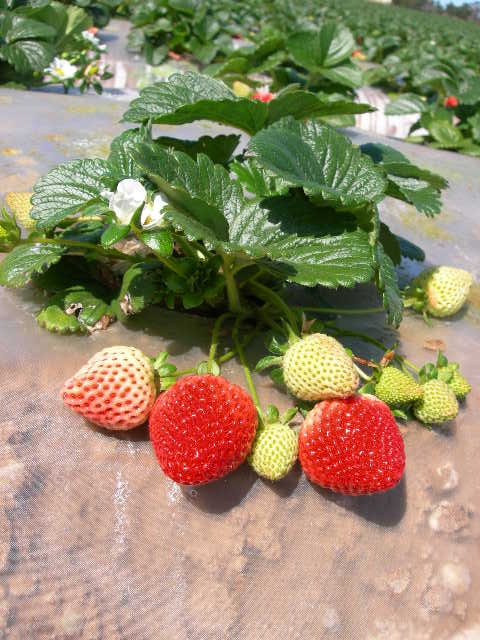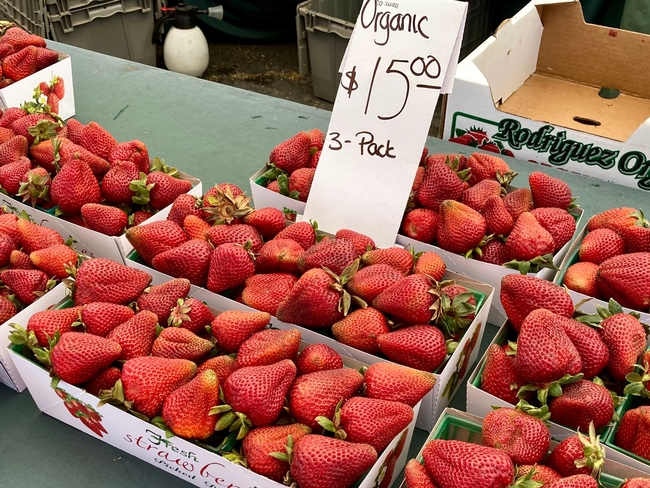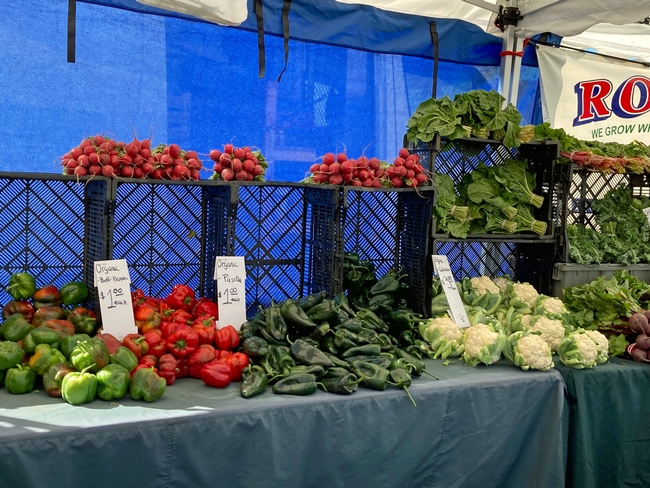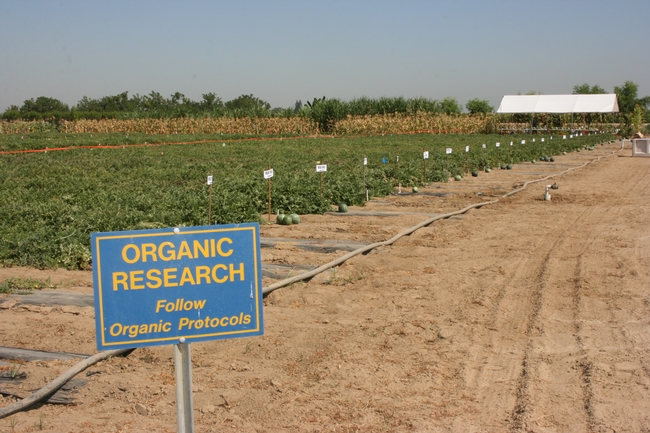Posts Tagged: organic
Pitahaya/dragon fruit growers gather to learn from UCCE research and each other
Once you know what a dragon fruit looks like, you will never forget it. The bright red, sometimes yellow or purple, scaly skin makes for a dramatic appearance. One that will surely leave an impression. The flesh ranges from white to a deep pink and the flavor is often described as having hints of kiwi, watermelon, or pear.
Since 2007, the Pitahaya/Dragon Fruit Production Tour, has united dragon fruit growers of all levels and backgrounds. After a two-year hiatus due to the pandemic, registration for the 2022 tour filled up in less than 24 hours.
A group of 60 participants gathered Sept. 8 at the Wallace Ranch Dragon Fruit Farm in Bonsall to learn the latest research on growing the drought-tolerant specialty crop. Ramiro Lobo, a small farms and agricultural economics advisor for UC Cooperative Extension in San Diego County, introduced dragon fruit growers and other UC scientists.
“I can't remember a year where this event was not sold out. So, the need and demand is there,” said Eyal Givon, a long-time participant and dragon fruit grower.
The tour not only demonstrates how to grow the fruit, but it also grants participants access to plant material for varieties that are unavailable elsewhere.
“We have given out about 50,000 cuttings through our festival and some varieties were unique to us because we introduced them to the U.S.,” said Lobo.
During their time at Wallace Ranch, participants heard from the farm's owner, Neva Day, regarding the growing practices that have shaped her success today. Day has been growing organic dragon fruit since 2013 and has well over 5,000 plants on the ground and more than 20 varieties.
Eric Middleton, UCCE integrated pest management area advisor for San Diego County, talked about managing insects and pests that growers are likely to encounter such as Argentine ants.
According to Middleton, Pecan Sandies are a balanced source of fat, protein, and sugar, making them excellent bait for the sugar-loving insects.
Participants eventually made their way to Dragon Delights Farm located in Ramona. Kevin Brixey, the farm's owner, has been growing organic dragon fruit for six years.
Although Brixey was hosting this year's tour participants, he used to be one of them.
“I attended the Pitahaya Festival in 2014 and that's where I realized dragon fruit was something I could grow. There was a lot of good information being shared and a connection to other growers, so it was a major steppingstone for me,” he says.
Unlike traditional dragon fruit growers, Brixey uses shade to grow his dragon fruit after learning about the method from another grower.
“I was impressed. I liked how the fruit performed under shade and now I use it as a management tool,” Brixey explained. In Inland Valleys, shade can shield fruit from intense sunlight and protect them from unwanted guests that eat the fruit, such as birds.
At the Farm Bureau of San Diego County offices, participants learned about the history of dragon fruit growing in California, food safety, pest management, best production practices and much more.
The presenters included experts like Paul Erickson from Rare Dragon Fruit, Lobo, Middleton, Johanna del Castillo from UC Davis Department of Plant Pathology and Ariana Reyes, a community education specialist from UCCE San Diego.
When reflecting on his time participating in the production tour, Givon, who has been growing dragon fruit for about 20 years and manages a 20-acre farm in Moorpark, said he enjoys reconnecting with other growers the most.
“What others are doing, might be better than what I'm doing,” Givon said. “Or what I'm doing, could be better than what someone else is doing. This time together is good for us to learn from each other.”
Lobo agreed with Givon and added, “I hope that these tours become self-sustained, and that we go back to a research field day at Southcoast REC with regional tours in San Diego and Ventura as we did before, or any other counties.”
The Pitahaya/Dragon Fruit Production Tour is an annual event hosted by UCCE San Diego. To learn more about UCCE San Diego events, visit https://cesandiego.ucanr.edu.
UC study breaks down costs of growing organic strawberries
Thinking about commercially growing organic strawberries on the Central Coast?
To help prospective and current growers evaluate financial feasibility, the University of California has estimated costs to produce and harvest organic strawberries for fresh market in Santa Cruz, San Benito and Monterey counties.
“This revise of the last cost-of-production study incorporates the newest in labor costs along with updates on cultural techniques,” said study co-author Mark Bolda, UC Cooperative Extension strawberries and caneberries advisor in Santa Cruz, San Benito and Monterey counties.
The new study, “Sample Costs to Produce and Harvest Organic Strawberries in the Central Coast Region-2022,” has been released by UC Agriculture and Natural Resources and UC Davis Department of Agricultural and Resource Economics.
The analysis is based on a hypothetical well-managed organic strawberry farm using practices common to the region, but the costs, materials and practices shown in this study will not apply to all farms. Growers, UC Cooperative Extension farm advisors and specialists, pest control advisers and others provided input and reviewed the methods and findings of the study.
“Current growers can use it as a baseline to compare with their own cost and returns estimates to make sure they have an accurate picture of the profitability of their organic strawberry enterprise,” said co-author Brittney Goodrich, UC Cooperative Extension agricultural economics specialist. “Many agricultural lenders use these studies as a baseline to determine whether to approve operating or investment loan requests from current and potential strawberry growers.”
The researchers assume a farm operation size of 30 contiguous acres of rented land, with strawberries are planted on 27 acres. The study includes a list of suitable strawberry varieties for the region, but no specific variety is used in the study. The crop is harvested by hand and packed into trays containing eight 1-pound clamshells from April through early October, with peak harvest in June through August.
The authors describe the assumptions used to identify current costs for production material inputs and cash and non-cash overhead. Ranging analysis tables show net profits over a range of prices and yields. Other tables show the monthly cash costs, the costs and returns per acre, hourly equipment costs, and the whole farm annual equipment, investment and business overhead costs.
The study's expanded section on labor includes information on California's new minimum wage and overtime laws.
“It's reached a wider audience this time through presentations of the material to students at Cal Poly [San Luis Obispo] and also a group of USDA officials at the California Strawberry Commission,” said Bolda.
“All of this just underlines the value of these studies to California growers and others working in agriculture,” Bolda said.
Free copies of this study and other sample cost of production studies for many commodities are available. To download the cost studies, visit the UC Davis Department of Agricultural and Resource Economics website at https://coststudies.ucdavis.edu.
This cost and returns study was funded by the UC Davis Department of Agricultural and Resource Economics.
For additional information or an explanation of the calculations used in the studies, contact Jeremy Murdock, UC Davis Department of Agricultural and Resource Economics, at jmmurdock@ucdavis.edu or UC Cooperative Extension's Bolda at (831) 763-8025.
Organic farmers to get technical assistance from CDFA and UC ANR
The California Department of Food and Agriculture is awarding $1.85 million to the University of California Agriculture and Natural Resources to increase technical assistance for California's organic farmers.
CDFA's State Organic Program is executing $850,000 in contracts with UC ANR to run through September 2024, while CDFA's Office of Environmental Farming and Innovation is awarding a $1 million grant to run from July 2022 to June 2025.
“California farmers provide 36% of all organic production in the United States,” said CDFA Secretary Karen Ross. “This funding expands technical assistance to growers transitioning to certified organic agriculture and supports our strong California community of organic farmers and consumers by conducting field trials and demonstration projects with farmers to improve organic practices.”
California organically farms just over 2 million acres, which is about 8% of the total agricultural acreage in the state, and will likely continue to expand over time as long as consumer demand continues to rise, according to Houston Wilson, director of UC ANR's Organic Agriculture Institute.
“Demand for organic agriculture has consistently grown every year for the past two decades,” Wilson said. “Organic currently accounts for 5.8% of domestic food sales.”
“We are excited to see CDFA increasing support for organic agriculture as part of a broader climate-smart agriculture strategy,” said Wilson. “As demand for organic continues to rise, California growers need increasingly targeted technical assistance in all areas of organic production and marketing.”
The CDFA funds will allow UC ANR to hire two academic coordinators, which are currently being recruited.
“The academic coordinators will work directly with growers, as well as develop research and extension projects that will involve existing UC Cooperative Extension personnel,” Wilson said. “One of the coordinators will specifically focus on connecting our efforts with small-scale and historically underserved growers through our partnership with the UC Small Farms Program.”
The organic practices can be used by conventional farms as well as organic farms.
“Just as organic farmers benefit from UC ANR's pest management, irrigation and crop production research, the new knowledge developed on organic practices by the UC Organic Agriculture Institute will be useful for all California farmers,” said Glenda Humiston, UC vice president for agriculture and natural resources.
Some of the key UC ANR project objectives include:
- Conduct research on soil health management, carbon sequestration and crop rotations in organic systems
- Create new extension and training opportunities for organic growers across California
- Provide technical assistance to both certified and transitioning organic growers
- Review and summarize organic acreage and practices in California
- Develop economic analysis of organic production and markets
“Clif Bar is proud to have supported the creation of the UC Organic Agriculture Institute and congratulates them on this new and important funding,” said Philippa Lockwood, Clif Bar social responsibility program manager. “Supporting the advancement of organic agriculture in our home state of California and the great work that's to come from the UCOAI is a true honor and we look forward to their impactful agricultural innovations ahead.”
The 2022-2023 state budget signed last week by Gov. Gavin Newsom includes $5 million in funds for CDFA to assist farmers with transitioning to organic operations, and the USDA recently announced an investment of up to $300 million for the same purpose.
Updated July 18, 2022, to add Philippa Lockwood quote.
New California Organic Research Agenda available online
Organic Farming Research Foundation (OFRF) has published the new California Organic Research Agenda (CORA), a comprehensive report that examines current needs and challenges of organic farmers and ranchers across California and provides policy and research recommendations to address producer-identified issues.
The CORA report is a companion to OFRF's 2022 National Organic Research Agenda. The national organic survey data boasts responses from over 1,100 producers and 16 listening sessions held across the U.S. Using the California subset of the national survey data, the CORA report highlights the top production and non-production challenges cited by California's organic farmers and ranchers.
“Organic farming has been historically under-invested in, in terms of research, education and extension,” says OFRF Executive Director Brise Tencer. “Both the new California Organic Research Agenda and the 2022 National Organic Research Agenda present incredible feedback directly from organic farmers and provide a compelling roadmap for how to best support the growth of this important sector of agriculture.”
Report findings indicate that managing production costs is a substantial challenge for 71% of producers surveyed, and accessing labor proved to be the leading non-production challenge. An overwhelming number of state producers (76%) expressed substantial need for technical assistance with the organic management of weeds, pests, and disease. In addition to detailing farmer challenges on and off the field, OFRF's CORA report provides a comparison analysis of farmer responses based on commodity and farming experience. National and state comparisons are also included in the report.
Production of the CORA report was supported in part by the University of California Organic Agriculture Institute, a new statewide program within the UC Division of Agriculture and Natural Resources, as well as the UC Santa Cruz Center for Agroecology.
“One of our primary activities is to generate new research and extension programs focused on organic agriculture,” says Houston Wilson, director of the UC Organic Agriculture Institute. “The CORA report provides an excellent roadmap to guide and prioritize our efforts, we're really excited to turn this information into action.”
According to the California Department of Food and Agriculture, state farmers and ranchers were responsible for 40% of all organic agricultural product sales in the country. Data from a 2019 USDA organic survey concludes California has 965,257 acres in organic production, which is approximately 17.5% of all organic acreage in the country. OFRF's California Organic Research Agenda examines grower needs in the nation's top-producing state of organic agricultural commodities and specialty crops, paving the way for future research and investment.
"This report will benefit organic growers in California by playing a role as a critical reference to increase public support and develop research projects targeting specific needs that diverse organic growers in the state are facing," says Joji Muramoto, UC Cooperative Extension organic production specialist based at UC Santa Cruz.
The CORA report is available free online at https://ofrf.org/research/nora for farmers, policymakers, agricultural suppliers, seed companies and the general public.
Free weekly organic agriculture seminars for growers
Growers are invited to attend free organic agriculture seminars hosted by UC Cooperative Extension. Lunchtime seminars will be offered on Tuesdays from 12 to 1 p.m. through March 8.
The 30-minute presentations will be delivered online via Zoom, followed by questions from the listeners and general discussion. The exception is a three-hour workshop on management of Fusarium wilt and other soilborne fungal pathogens in organic systems, from 8:45 a.m. to 12:30 p.m. on Feb. 15.
Water management, weed control, grafting heirloom tomatoes, organic nitrogen management, soilborne diseases, biostimulants, biocontrol agents and mycorrhizal fungi will be discussed by UC Agriculture and Natural Resources scientists and guest speakers.
For the full schedule of presentations and speakers, visit https://bit.ly/organicagseminars. Spanish speakers can see the agenda en Español.
The Zoom link (https://ucanr.zoom.us/j/97511217168?pwd=ZWVhVXorcFEzRHUwQ0Q0L1lqaHNWdz09) for the series will be the same each week. No pre-registration is required.
The presentations will be recorded and made available at https://bit.ly/organicagseminars.


